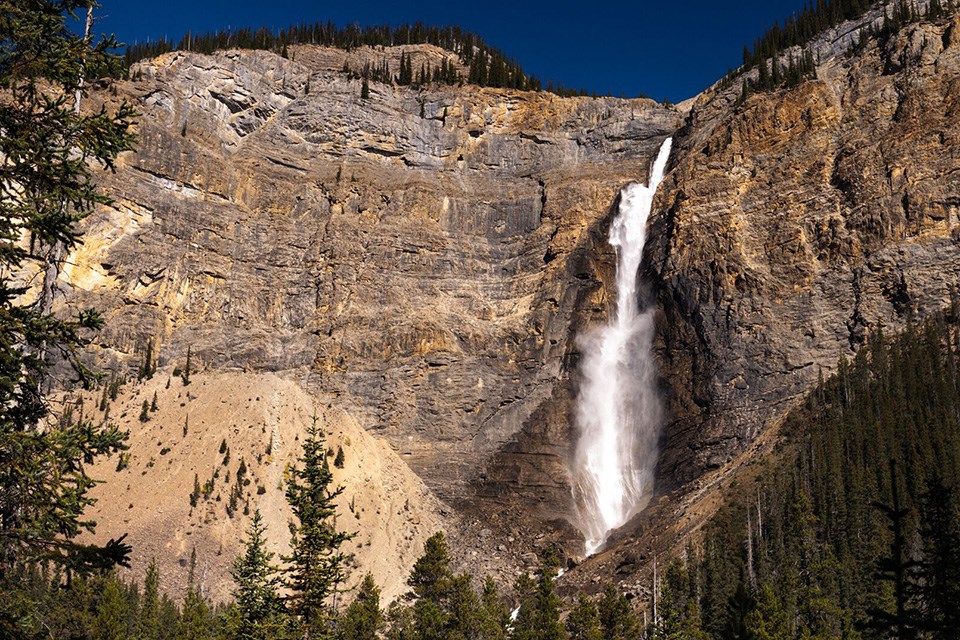There’s something quintessentially Canadian about seeking out and visiting massive, plunging waterfalls each summer. If you’ve been following the Hot Summer Guide for a while, you know that we fancy ourselves waterfall connoisseurs. Well, friends, we’re finally dipping our toes outside of the Alberta border, and we think you should probably join us. Today, we’ve got a real treat for you. Canada’s second-highest waterfall is located just a short distance outside of Alberta. And don’t let the whole second-place title fool you, these falls are positively massive.
You’ll find this beauty in Yoho National Park. This must-see phenomenon offers a blend of natural beauty and adventure, a destination that shouldn't be missed. Located just a short drive from the Alberta-British Columbia border, this stunning waterfall promises an unforgettable experience for nature enthusiasts and casual travellers alike. If adventure and breathtaking natural beauty call your name, set your sights on Takakkaw Falls.
These spectacular falls are a sight that truly lives up to their name, which translates to "magnificent" in Cree, and it’s easy to see why. Standing at an impressive height of 373 metres, Takakkaw Falls proudly claims the title of Canada's second-highest waterfall, promising awe-inspiring views that will take your breath away.
Fed by the Daly Glacier, part of the Waputik Icefield, the falls are most powerful during the summer months when glacial melt surges down from the mountain peaks, creating one of Canada’s most magnificent natural attractions.
Reaching Takakkaw Falls is an adventure in itself. From the Trans-Canada Highway, take the Yoho Valley Road near the town of Field, British Columbia. The 13-kilometre drive is scenic but features tight switchbacks, making it unsuitable for trailers or large RVs. Depending on weather conditions, the road is typically open from mid-June to mid-October.
Once you arrive at the parking area, a well-maintained, short and sweet 1.4-kilometre round-trip trail leads you to the base of the falls. The path is relatively flat and accessible, making it suitable for visitors of all ages and abilities. As you approach, the roar of the cascading water grows louder, and the mist from the falls provides a refreshing coolness on warm days.
While Takakkaw Falls alone is worth the trip, Yoho National Park is full of other stunning attractions to round out your adventure. Emerald Lake, famous for its vibrant turquoise waters and peaceful trails, and the popular Iceline Trail, which offers spectacular panoramic views of glaciers and peaks, are just a few nearby highlights. The area offers backcountry camping options for those looking to extend their stay and explore more of Yoho National Park’s beauty.
Why Takakkaw Falls is a Must-Visit
Takakkaw Falls is one of those rare places that’s as accessible as it is unforgettable. Whether you’re travelling with family, heading out for a casual hike, or simply chasing jaw-dropping scenery, this destination delivers. The short, well-maintained trail makes it easy for visitors of all ages and abilities to get right up close to the base of the falls. And trust us, you’ll want to.
Surrounded by towering cliffs, lush alpine forest, and glacier-fed rivers, the falls offer some of the most incredible photo opportunities in the Rockies. The sheer scale of the cascade, paired with the sound, mist, and motion of the water, creates an experience that goes beyond just sightseeing. Plus, with its proximity to popular spots like Banff, Lake Louise, and Emerald Lake, it’s a seamless addition to any Rocky Mountain itinerary.
Tips for Visiting Takakkaw Falls
For the best experience, plan your visit between late June and early September, when the glacial melt is at its peak and the falls are truly roaring. While the short walk from the parking lot is easy, you’ll want to bring layers and waterproof clothing, especially if you’re planning to get up close. The mist from the falls is strong enough to soak you, and on a hot day, it’s surprisingly refreshing.
Before heading out, check road conditions and trail updates on the Parks Canada website. Yoho Valley Road is typically open from mid-June to mid-October, but weather can impact access. The road is also narrow with tight switchbacks, so trailers and large RVs are not recommended.
Britanny Burr is a freelance writer and a contributor to Great West Media. This story was written for Great West Media's Hot Summer Guide advertising feature. The Hot Summer Guide is a special feature about summer activities, bucket list adventures, staycation options, road trips, attractions, events, and road trip-worthy food & beverage destinations across Alberta. It is not written by and does not necessarily reflect the views of the editorial staff.



